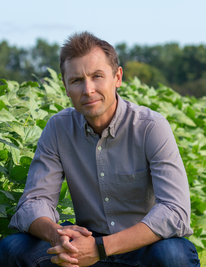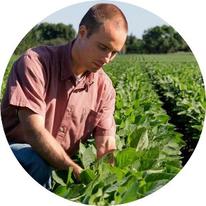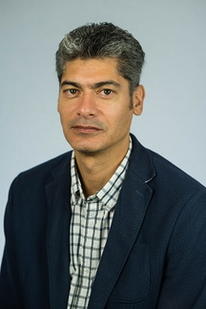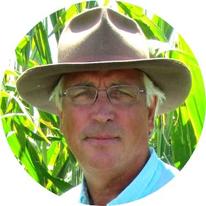The University of Minnesota Soybean Research Center features researchers from across all departments in the College of Food, Agricultural and Natural Resource Services, including Animal Science; Plant Pathology; Applied Economics; Food Science & Nutrition; Agronomy & Plant Genetics; Soil, Water and Climate; Entomology; Microbial and Plant Genomics; and Plant Biology. It also includes researchers and Extension from many UMN Research and Outreach Centers across the state.
The diversity of research includes soybeans pests, plant stress resistance, ag technology economics and risks, food innovation, annual and perennial cropping systems, fertility and nutrient recycling, the economics of livestock and crop production, soybean and small grain genetics and breeding, international market expansion, poultry waste utilization, plant and soil health interaction, climate change impact on crop resilience, herbicide-resistant weeds, global food security, legume molecular genetics, and more.
Soybean Research Center Faculty by Department
Agronomy & Plant Genetics

Cory Hirsch
Plant Stress Resistance Biology
Plants respond to stresses by triggering a collection of molecular and cellular processes. Plant stresses can be abiotic, such as extreme temperatures, salinity, and drought; or biotic, such as pathogens and herbivores. These stresses affect the plants ability for proper growth, total yield, quality, and survival.
My group is largely interested in using enabling technologies to understand genomic and expression variation within species and associating these with phenotypic information to understand abiotic and biotic stresses. This includes understanding how this variation is manifested and how this variation influences phenotypes. We are utilizing a myriad of approaches towards increasing and sustaining plant health, including understanding responses to extreme temperatures and salinity, the role of the microbiome in plant stress response, and plant pathogen interactions, by asking questions about global gene expression responses, the mechanisms of response, the genome architecture of plants and pathogens, metabolite profiles, and precise and reproducible large-scale phenotyping. While using cutting edge technologies can answer important biological questions, we also focus on determining the limitations of data analyses using these technologies to enable accurate biological interpretations, especially in complex plant genomes.

Gregg Johnson
Integrated weed management (Southern ROC, Waseca). Cropping Systems
Biography
I specialize in annual and perennial cropping systems with a focus on maximizing productivity, efficiency, and ecosystem services. My work emphasizes applied production strategies that are designed around multi-value outcomes.

Aaron Lorenz
Soybean Breeding and Genetics
Aaron traces his interest in plant breeding all the way back to his childhood on the farm where he learned firsthand how useful new crop varieties are for improving yield and providing resistance to various pests and other stresses.
Throughout college he grew an interest in genetics and statistics alongside his lifelong passion for agriculture. Aaron currently manages a broad-based program in soybean breeding and genetics at UMN that strives to integrate applied cultivar development with research on new breeding methods and the genetic control of economically important traits. Students from all different backgrounds are a key element of the program to educate future scientists to work in improving the sustainability and resiliency of agriculture.

Gary Muehlbauer
Wheat and Barley Molecular Genetics
Research
My position is focused on wheat and barley molecular genetics. One area of my research is directed towards Fusarium head blight (FHB) of wheat and barley. Another research area is focused on developing and integrating genomics resources into barley breeding programs. Other areas involve identifying genetic variation in wild barleys for use in germplasm enhancement, and to genetically characterize a collection of barley tillering mutants.

Seth Naeve
Soybean management.
Research
- Applied soybean production and physiology research focused yield and seed quality enhancement
- Soybean production Extension program
- International market expansion of bulk commodity and food grade soybean and soybean products
Animal Science

Sam Baidoo
Swine Nutrition
Research
- Nutrition and management factors to enhance economic and environmentally sustainable swine production.
- Energy and amino acids nutrition of sows and impact on sow productivity and longevity.
- Evaluation of alternative feeds and feeding and management strategies to improve economic efficiency in swine production.

Jerry Shurson
Swine Nutrition
Research
- Life Cycle Assessment of feed ingredients
- Biosecurity of feed ingredient supply chains
- Measurement and mitigation strategies for African Swine Fever virus in feeds
- Applied swine nutrition and management
- Distillers dried grains with solubles (DDGS)
- Systems biology
- Understanding and improving fiber utilization
- The measurement and role of peroxidized lipids on animal health and performance
- The role of phytate in phosphorus and nutrient utilization
- Alternatives to antibiotic growth promoters
- Feed safety
- Enteric health interventions
- Biological effects of organic zinc
- Nutrient recycling
- Nutritional value and characteristics of rendered animal by-products
- Organic food waste
- Use of food and agricultural wastewater streams to produce microalgae for animal feed
- Pork quality and safety
- Manure management and odor reduction in swine facilities
Applied Economics

Terry Hurley
Natural Resource Economics, Production Economics, Science and Technology Policy
Research
Primary research interests include the profitability, risk, and regulation of emerging agricultural technologies. Technologies of interest include genetically engineered herbicide-tolerant crops, genetically engineered plant-incorporated-protectants (PIP), host plant resistance, and information-intensive farm management. Issues of interest related to these technologies are the identification of management or regulatory strategies that increase their durability and long-term value. Examples include strategies for managing herbicide-resistant weeds and PIP-resistant insects. Research interests also include the assessment of the non-monetary benefits (e.g., simplicity, flexibility, convenience, risk, and human and environmental safety) to farmers of alternative agricultural management practices.
Extension and Outreach
Herbicide Resistance Management Insect Resistance Management
Entomology

Robert Koch
Integrated pest management, crops pests, remote sensing, insecticde resistance, host plant resistance, biological control, sampling
Research
My research program focuses on applied ecology and integrated pest management of arthropods associated with crops, primarily soybean. The goal, in conjunction with my extension program, is to improve the environmental and economic sustainability of crop production through integrated pest management. The research program is broadly based, emphasizing scouting (sampling and remote sensing) and evaluation and integration of control tactics (chemical and biological controls and host plant resistance).
Current research areas include…
Soybean aphid:
- Remote sensing
- Insecticide resistance
- Insecticide efficacy
- Host plant resistance
Stink bugs:
- Biological control
- Sampling
Soybean gall midge:
- Biological control
- Overwintering biology
Pennycress entomology: Identify pests and quantify their impacts to this new crop
Extension
Research-based guidance for management of soybean pests is shared with farmers and agricultural professionals through multiple routes.
Research
The Lindsey Lab uses functional genomics to understand insect biology and reproduction in the context of symbiotic associations. The evolutionary history of eukaryotes is tightly linked to endosymbiosis and sexual reproduction. Not only was the evolution of eukaryotic life facilitated by the acquisition and vertical inheritance of intracellular microbes, but intracellular symbionts, organelles, and pathogens continue to sculpt the evolutionary trajectories of eukaryotes broadly. In insects and other arthropods, there is an abundance of recently acquired endosymbionts that have evolved mechanisms for altering host sex and reproduction. Approximately half of all insects are infected with one such bacterium: Wolbachia. Despite how common Wolbachia is, we know relatively little about the mechanisms by which Wolbachia establishes infection in insects and alters their biology. Our research merges molecular biology, genomics, evolution, computational biology, microbiology, and entomology to uncover fundamental mechanisms of species interactions with a major focus on the insect reproductive symbiont, Wolbachia.

Declan Schroeder
Declan Schroeder (PhD) was appointed in February 2018 through the Agricultural Research, Education, Extension and Technology Transfer (AGREETT) program. He is an Associate Professor of Virology in the Veterinary Population Medicine Department in the College of Veterinary Medicine at the University of Minnesota. He also holds an honorary Chair in Viral Metagenomics in the School of Biological Sciences at the University of Reading, United Kingdom. He was the former Director of the Marine Biological Association of the UK Culture Collection where he was also a Senior Research Fellow in Viral and Molecular Ecology (2001-2018).
He has over 20 years of research experience as a molecular biologist in the areas of virology, biodiversity, pathology, and genomics – in particular, the use of genomic tools to study key biological processes. His research focusses on a diverse array of host-virus systems, however, more recently he has been focusing on a new virus resistance mechanism in honey bees.
His move to Minnesota means that the Schroeder lab will continue to develop molecular tools to enhance detection and surveillance; secure and improve agricultural productivity through an improved understanding of the true impact of:
- viral pathogens on honey bee health
- viral pathogens on swine respiratory disease
- virus or phage therapy in pig, cattle and fish farms
- the Virome in disease outcomes in pig, cattle, honey bee & aquatic production systems
Extension

Anthony Hanson
Dr. Anthony Hanson is an entomolgist and Assistant Extension Professor & Regional Educator in Integrated Pest Management for field crops with University of Minnesota Extension based out of Morris, MN. He focuses on providing tactics farmers can use to make sound economic and environmentally relevant pest management decisions, including pest forecasting. He also hosts the University of Minnesota IPM Podcast for Field Crops. Anthony grew up farming near Brooten in west-central Minnesota growing crops, raising cattle, and managing pastures. He is still actively involved in the family farm where he also keeps honeybees.

Bruce Potter
Interactions between crop pests (insects, nematodes, plant disease, and weeds) with crop growth and yield
Biography
Bruce Potter is an Extension Integrated Pest Management (IPM) Specialist at the University of Minnesota Southwest Research and Outreach Center near Lamberton. He’s been working at the SWROC and conducting research throughout southwest Minnesota since 1997.
Research
Current research and extension efforts focus primarily on the management of pests of corn and soybean. In addition to contributing to research and extension articles, he has published a growing-season SW MN IPM Newsletter since 1999.
Food Science and Nutrition

Chi Chen
- Mechanistic investigations on the metabolic changes induced by dietary, chemical, microbial, and pathophysiological challenges through mass-spec metabolomics, metabolite analysis, stable isotope tracing, in vitro biochemical analysis, animal model, and human intervention treatment.
- Metabolite profiling and analysis in the lab cover both endogenous metabolites (lipids, amino acids, organic acids, aldehydes, ketones, and microbial metabolites) and exogenous metabolites (phytochemicals, pharmaceuticals, carcinogens, and their metabolites) in biofluids, wastes, tissue and cell extracts

B Pam Ismail
- Protein chemistry
- Structure/function relationship of proteins
- Sustainable crops for functional ingredients
- Protein structural characterization using proteomics
- Optimization of protein extractions following industry feasible approaches
- Protein functionalization
Research
The main focus of our research is improving the functionality and bioactivity of proteins. Specifically, our group focuses on chemical characterization and enhancement of functionality, safety, bioavailability, delivery, and bioactivity of food proteins, following novel extraction, processing, and analytical approaches. We research ways to improve functionality, thermal stability, and bioactivity of food proteins following enzymatic and other natural protein modification approaches. Protein structural characterization is performed using a number of proteomic analytical tools, aiming at linking structure to function. Our lab has targeted proteins from common sources, including soy, wheat, whey, and casein. However, plant-based proteins are more in demand than ever before. The demonstration of equivalent or superior/new functionality of novel plant proteins compared to existing alternatives is essential to both the food industry and the consumer. Therefore, our lab embarked on studying and evaluating protein from several plant sources including pulses, oilseeds, cereal grains, and hemp (https://ppic.cfans.umn.edu/research/current-research-projects). Our lab also added sustainable crops to its repertoire. Most notably, we have been researching novel perennial crops including intermediate wheatgrass grains (grains related to wheat), millet, and most recently the oilseeds pennycress and camelina. These crops have excellent environmental benefits, among them reduced soil and water erosion, increased carbon sequestration, and reduced nitrogen leaching. Through a collaborative effort with geneticists, breeders, and agronomists, we are ultimately working to see them commercialized for food applications. Our food science team focuses on characterizing the crops, conducting storage studies, and understanding and improving their functionality.
Horticultural Science
Plant Pathology

Senyu Chen
Nematology
My research interests include the biology, ecology, and management of plant-parasitic nematodes. Research focuses on the soybean cyst nematode (SCN), Heterodera glycines, and other plant-parasitic nematodes in the soybean-corn production systems. The overall goals are to develop better management strategies and minimize yield loss caused by SCN and other nematodes. A series of studies has examined the effectiveness of the cultural, biological, and chemical controls of plant-parasitic nematodes. Specifically, research projects involve the identification of SCN-resistance and tolerance genes and soybean lines; developing soybean lines and cultivars using novel SCN-resistance; determining life cycle, population dynamics, and race composition of SCN in Minnesota; studying interactions of SCN with other diseases, and associated soil biotic and abiotic factors; optimizing crop rotation schemes for SCN management; studying biological control of SCN and other nematodes; evaluating commercial soybean cultivars for SCN-resistance and yield potential; evaluating commercial chemical and biological nematicides for the control of SCN and other nematodes; studying tillage and soil fertility effects on soybean cyst nematodes and crop yields; studying soil microbial communalities associated with nematodes and crop yields; and studying nematode communities.

Dean Malvick
Biology and Management of Field Crop Diseases
Plant diseases caused by fungi, Oomycetes, and bacteria can dramatically reduce yield and quality of crops. They are serious economic problems as well as fascinating biological puzzles that can clarify the complex interactions between microbes and plants. My work at the University of Minnesota is divided between conducting research and developing extension education programs on the biology and management of crop diseases.
I focus my research program on the biology and management of fungal and Oomycete plant pathogens and their interactions with plants. One goal is to improve disease management and diagnosis via problem-solving research. Another general goal is to discover new knowledge on the biology and ecology of important plant pathogens that will lead to development and implementation of new and improved disease management strategies. Three broad objectives underlie these goals: (i) determine characteristics of pathogen populations, (ii) understand associations and interactions between fungal pathogens and soybean at the organismal level, and (iii) develop and validate specific molecular diagnostic techniques for detection of plant pathogens. The work is done in laboratory, growth chamber, greenhouse, and field environments. Recent work has focused on sudden death syndrome, brown stem rot, and root rots of soybean; and on Goss’s wilt of corn.
My primary extension responsibility is to develop and deliver educational programs for producers, extension educators, and other agricultural professionals regarding the occurrence and characteristics of crop diseases as well as strategies for their management using effective, economic, and environmentally sound strategies.

Megan McCaghey
My research is centered on translational research of soil-borne fungi that cause crop diseases. More specifically, I am interested in questions related to understanding the ecology and epidemiology of soil-associated fungi and oomycetes and enhancing host disease resistance to improve management. I am also passionate about teaching using learner-centered and inclusive teaching strategies.

Ashish Ranjan
I am a molecular plant pathologist whose expertise and interest are in the area of plant-pathogen interaction. My research goal is to understand plant-microbe interactions to enhance plant health, developing sustainable strategies to improve crop yields, and finding solutions to important agriculture problems. My primary research area is to understand the dynamics of the soil-borne fungal pathogens, such as Sclerotinia sclerotiorum, its virulence, and the resistance/susceptibility mechanism of different host plants using omics, genetics, biochemical and molecular biology approaches.
Soil, Water, and Climate
Research
- Maintenance of fertilizer guidelines and evaluation of soil test methods for commodity crops
- Nutrient cycling in cropping rotations - emphasis on sulfur
- Fertilizer placement - focus on planter banded fertilizer use in corn
- Development and use of precision agriculture technologies in research and crop production


